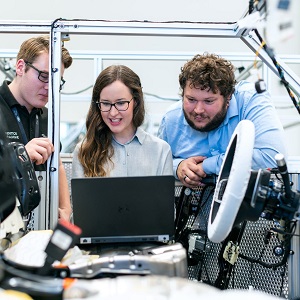Evolution of Engineering Education: How Technology Has Changed the Learning Process
 In today’s world, engineering education has taken on a new dimension. This is due to the emergence of new technologies and the ever-evolving nature of the engineering profession. The transformation of engineering education in India has been driven by the need to equip engineers with the skills and knowledge to tackle the challenges of the modern world. In this article, we will explore the need for transformation and how technology has transformed engineering education. We will also look at examples of technology-enabled learning and the benefits, challenges, and future of engineering education.
In today’s world, engineering education has taken on a new dimension. This is due to the emergence of new technologies and the ever-evolving nature of the engineering profession. The transformation of engineering education in India has been driven by the need to equip engineers with the skills and knowledge to tackle the challenges of the modern world. In this article, we will explore the need for transformation and how technology has transformed engineering education. We will also look at examples of technology-enabled learning and the benefits, challenges, and future of engineering education.
The Need for Transformation
The need for a transformation of engineering education has become more pressing in recent years. This is due to the rapid advancement of technology and the emergence of new technologies such as artificial intelligence (AI), big data, and the Internet of Things (IoT). These technologies are changing the way engineers and engineering students approach their studies. In order to remain competitive in the engineering profession, engineers must be prepared to embrace new technologies and be able to use them in their work.
In addition, technology is impacting the way engineers and engineering students learn. Traditional methods of teaching such as lectures and textbooks are becoming less effective as students’ attention spans decrease. In order to keep up with the changing times, engineers must be equipped with the skills and knowledge to adapt to new technologies and use them in their work.
How Technology Has Transformed Engineering Education
In recent years, technology has had a profound impact on engineering education. It has enabled the emergence of new teaching and learning methods such as online courses, virtual labs, and simulations. These methods have made it easier for engineers and engineering students to acquire knowledge and skills in a more efficient and effective manner. Online courses are becoming increasingly popular among engineers and engineering students as they provide access to a variety of learning materials such as lectures, tutorials, and simulations.
Example of technology-enabled learning is virtual labs. Virtual labs allow engineers and engineering students to conduct experiments and practice their skills in a safe and controlled environment. They provide access to a variety of tools and equipment that can be used to simulate real-world scenarios and test hypotheses.
Benefits of Technology-Enabled Learning
The emergence of technology-enabled learning has provided engineers and engineering students with numerous benefits. One of the most important benefits is the ability to gain knowledge and skills in a more efficient and effective manner. Technology-enabled learning allows engineers and engineering students to access a variety of learning materials such as lectures, tutorials, and simulations. This makes it easier for them to acquire knowledge and skills in a more efficient and effective manner. Technology-enabled learning allows engineers and engineering students to interact with each other and exchange ideas. This is beneficial as it allows them to gain insight into different perspectives and develop a better understanding of the subject matter.
Challenges Faced by Technology-Enabled Learning
Despite the numerous benefits of technology-enabled learning, there are also several challenges that must be addressed. One of the most significant challenges is the cost of implementing technology-enabled learning. In order to be effective, technology-enabled learning requires significant investment in hardware and software. This can be a significant barrier for many engineering students and institutions that may not have the resources to invest in technology-enabled learning.
In addition, technology-enabled learning requires a certain level of technical expertise. In order to use technology-enabled learning effectively, engineers and engineering students must be familiar with the technology and understand how to use it. This can be a challenge for many engineers and engineering students who may not have the necessary technical expertise.
Finally, technology-enabled learning can be time consuming. In order to use technology-enabled learning effectively, engineers and engineering students must be willing to invest the time and effort to learn how to use the technology. This can be a challenge for many engineers and engineering students who may not have the time or patience to invest in technology-enabled learning.
How to Prepare for the Future of Engineering Education
In order to prepare for the future of engineering education, engineers and engineering students must embrace new technologies and be willing to invest the time and effort to learn how to use them. A good place to start is by taking online courses and virtual labs to gain knowledge and skills in a more efficient and effective manner. In addition, engineers and engineering students should familiarize themselves with the latest technologies and understand how to use them in their work.
To Conclude
Technology has revolutionized the learning process and changed the way engineers and engineering students approach their studies. Through the use of online courses, virtual labs, and simulations, technology has enabled the emergence of new teaching and learning methods. These methods provide engineers and engineering students with numerous benefits such as the ability to gain knowledge and skills in a more efficient and effective manner. In order to prepare for the future of engineering education, engineers and engineering students must embrace new technologies and be willing to invest the time and effort to learn how to use them.

